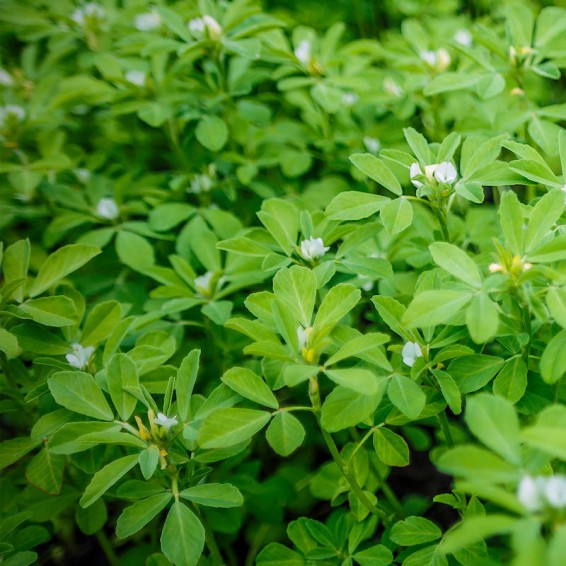Organic Fenugreek Seeds
Trigonella foenum-graecum
- HOW TO GROW
- FAST FACTS
HOW TO GROW
Sowing: Fenugreek can be difficult to transplant, so direct sowing is the best option; this herb thrives in full sun and rich well-drained soil, but it will grow in nearly any kind of soil. A warm weather plant, it should be planted several weeks after the last spring frost. Sow the seeds thickly 1/4" deep, thinning to 4" apart when the seedlings appear. Germination should take place within a week; to improve the germination rate, soak the seeds overnight before planting. Fenugreek also makes an excellent container plant, and can be sprouted for microgreens.
Growing: Keep the soil consistently moist and control weeds. A layer of mulch may help with this, as well as protecting the leaves from too much soil contact. Fenugreek cannot tolerate frost, so if cold weather threatens provide protection.
Harvesting: Fenugreek leaves can be harvested at any time from the microgreen or sprout stage to their mature size. When the plant begins to flower, however, the culinary quality of the leaves declines. To store the fresh leaves, wash them carefully and strip them from the stems; store them in the refrigerator for up to 3 days. The leaves can also be dried or frozen. To collect the seeds, wait until they rattle in the pod and shell them like peas. Store the seeds in an airtight container for up to 6 months.
Seed Saving: When the seeds reach maturity, the pods will turn yellow and the seeds will rattle inside. Pick the ripe pods and shell them like peas to remove the seeds. Store the seeds in an airtight container in a cool, dry place.
FAST FACTS
Latin Name: Trigonella foenum-graecum
Type: Open Pollinated, Heirloom, Warm Season
Life Cycle: Annual
USDA Zones: 3, 4, 5, 6, 7, 8, 9, 10, 11, 12
Seeds per Ounce: 1,760
Planting Method: Direct Sow
Planting Depth: 0.25
Planting Spacing: 16
Days to Maturity: 120
Sunlight: Full Sun
Height: 24 Inches
Color: Green
Bloom Season: Blooms Late Summer, Blooms Early Fall
Uses: Aromatic
DESCRIPTION
HOW TO GROW
Sowing: Fenugreek can be difficult to transplant, so direct sowing is the best option; this herb thrives in full sun and rich well-drained soil, but it will grow in nearly any kind of soil. A warm weather plant, it should be planted several weeks after the last spring frost. Sow the seeds thickly 1/4" deep, thinning to 4" apart when the seedlings appear. Germination should take place within a week; to improve the germination rate, soak the seeds overnight before planting. Fenugreek also makes an excellent container plant, and can be sprouted for microgreens.
Growing: Keep the soil consistently moist and control weeds. A layer of mulch may help with this, as well as protecting the leaves from too much soil contact. Fenugreek cannot tolerate frost, so if cold weather threatens provide protection.
Harvesting: Fenugreek leaves can be harvested at any time from the microgreen or sprout stage to their mature size. When the plant begins to flower, however, the culinary quality of the leaves declines. To store the fresh leaves, wash them carefully and strip them from the stems; store them in the refrigerator for up to 3 days. The leaves can also be dried or frozen. To collect the seeds, wait until they rattle in the pod and shell them like peas. Store the seeds in an airtight container for up to 6 months.
Seed Saving: When the seeds reach maturity, the pods will turn yellow and the seeds will rattle inside. Pick the ripe pods and shell them like peas to remove the seeds. Store the seeds in an airtight container in a cool, dry place.
FAST FACTS
Latin Name: Trigonella foenum-graecum
Type: Open Pollinated, Heirloom, Warm Season
Life Cycle: Annual
USDA Zones: 3, 4, 5, 6, 7, 8, 9, 10, 11, 12
Seeds per Ounce: 1,760
Planting Method: Direct Sow
Planting Depth: 0.25
Planting Spacing: 16
Days to Maturity: 120
Sunlight: Full Sun
Height: 24 Inches
Color: Green
Bloom Season: Blooms Late Summer, Blooms Early Fall
Uses: Aromatic






